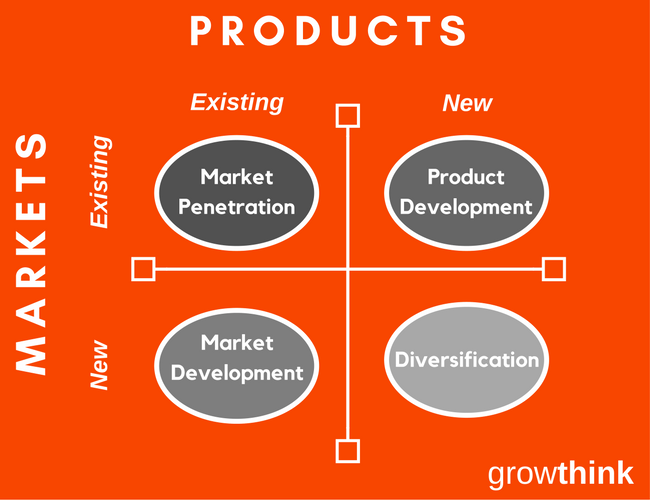“When you stop growing you start dying.”
– William S. Burroughs
Businesses need to grow.
If they don’t, new and/or existing competitors eventually capture more and more of their market share. And eventually force them out of business.
Unfortunately, most companies make mistakes when trying to grow. The 7 most common mistakes, and how to avoid them, are documented below.
1. Ignoring the Ansoff Matrix
The Ansoff Matrix, also called the Product/Market Expansion Grid, details the four most common ways you can grow your business. These four methods are selling:
- Your existing products to existing customers
- New products to existing customers
- Your existing products to new markets
- New products to new markets
Graphically, you can see the Ansoff Matrix as follows:

The key to the Ansoff Matrix is to understand that certain opportunities have higher risks of failure.
Specifically, selling your existing products to existing customers (“market penetration” – existing products, existing markets) is the least risky, since you have already proven that you can do it. Opportunities here are generally to try new marketing channels that let you reach more customers like your existing customers.
Offering new products to your existing customers (“product development” – new products, existing markets) requires that you take a bit more of a risk, since you don’t know for certain whether they will buy the new products. But since you already know and have a relationship with these customers, you have a relatively high chance of success.
Next, offering your existing products to new markets (“market development” – existing products, new markets) is even a bit riskier, since you don’t have relationships or a track record with customers in those markets.
And of course, finally, the riskiest opportunity is to sell new products to new markets. (“diversification” – new products, new markets) Offering a new product to a new market bears the risk of not knowing the customers and/or if your product or service will resonate with them. That’s not to say you shouldn’t try this; just that you must weigh the potential success against the increased potential for failure.
Most companies make the mistakes of:
- not judging new opportunities as they relate to the Ansoff Matrix (and thus assume unnecessary risk) and
- not diversifying their growth strategy enough and only operating in one of the Ansoff Matrix quadrants
2. Failing to Conduct Market Research
It’s relatively easy to come up with ideas to grow your business. It’s unfortunately a bit more work to conduct market research to judge the merit of these ideas.
Specifically, there are several market and marketing criteria against which you should judge your potential opportunities to figure out which ones are worth pursuing. These criteria are primarily focused on new product or service opportunities you identify, and include the following:
Big Market Size: is the market for your potential new product or service big enough? If the market is too small, it might not make a material impact to your bottom line — even if you achieve success.
Positive Market Trends: is the market for your potential new product or service growing, shrinking or flat? A shrinking market is clearly not a good indicator for your future success.
Competitive Gaps: How well are competitors filling the customer needs your potential new product or service seeks to fulfill? If the answer is not very well — then how quickly or easily do you think they could modify their offerings to directly compete with you?
Solving a Real Pain: How big is the customer pain that your potential new product or service solves? Is your offering a “nice to have” or “need to have” solution?
Customer Targeting: How identifiable and/or reachable are the customers you hope to serve with your potential new product or service? For instance, finding soccer players is very easy; identifying business owners who are interested in losing weight is a bit more challenging.
Make sure to conduct this research and judge your growth ideas against it to ensure you pursue only the worthiest opportunities. And then document these opportunities in your business plan.

3. Developing Weak Financial Models (or None at All)
Similar to failing to conduct market research to assess growth opportunities is the failure to create financial projections to assess them.
Specifically, you should create financial projections that show the potential impact on your bottom line should you choose to pursue these opportunities.
In developing these projections, be sure to identify the resources required to execute on the opportunity (including cash and human resources), the time needed (in months) to execute on the opportunity, and best, worse and average case scenarios.
Developing accurate financial projections for each potential growth opportunity will help you choose the one(s) that will have the greatest return on investment for your company
4. Forgetting What’s Worked in the Past
This critical mistake is best explained with a story. There was once a young man who had just graduated from college with an engineering degree. He did what most of his classmates did and got a job as an engineer. Within the next few years he got married and had his first child – and then another child.
But after working “for the man” for twenty years, he decided to start his own engineering consulting firm. While business was slow at first, he built up his firm over the years. In fact, 30 years after founding his company, he was generating millions of dollars in annual revenues.
But then, at the age of 72, he died. And he left the business to his 71-year-old wife.
Now his wife had never run a business in her life. In fact, she spent most of her days at the country club golfing and dining with her friends.
But within a year, she doubled the firm’s profits.
How did she do it?
Simple. She visited the company a week after her husband passed and sat down with the management team. And then she told them to do two things:
- Make me a list of the 5 things that worked the best in the last 12 months
- Make me a list of the 5 things that worked the least in the last 12 months
The list of things that worked included items like upselling current clients, getting new clients from partnerships they formed, and their program that hired and trained new sales reps. The things that didn’t work included radio advertising, sponsoring trade shows, and a new service offering that just didn’t catch on.
So, the widow made one demand: Do more of the 5 things that worked, and stop doing the 5 things that didn’t work.”
The management team listened. And within a year, the company’s revenues and profits both doubled.
Yes – it’s that simple. Your company should do more of the things that are proven to work and less of the things that haven’t worked.
Unfortunately, most business owners don’t do this, and here’s why: we’ve been told throughout our lives to improve our weaknesses and “never quit” – and we carry this lesson over to our businesses. So, when something doesn’t work, our first impression is typically to “work on it” or try to fix it.
However, that’s generally not the best solution. A much more effective approach is to do more of what is already working, since those are the things that are proven to work. Why try to fix an unproven concept when you already have figured out a winner?

5. Starting at the Wrong Place
“If you don’t know where you’re going, you probably won’t get there.”
– Yogi Berra
This quote from Yogi Berra is so simple, yet so true. If you don’t know where you want to go, you’ll never get there. It’s like driving in a foreign country without a map or GPS system.
And it’s the same with your business. If you don’t know where you want to take your business, how can you possibly get there? You can’t.
In business, as in everything else, you need to have a clear vision of where you want to go. Then, and only then, can you create a plan to get you there.
And this is the growth mistake that most companies make. They think too much about the upcoming month, quarter or year, when they need to think further in the future to reap both stronger long-term and short-term profits.
The key is to “Start at The End.” [click here for a copy of my book with this title]. Figure out where you want to go. And then reverse engineer the path to get there. Specifically, once you figure out what you want to accomplish by the end (i.e., in 5 or more years unless your goal is to exit sooner than that), you can estimate what you need to accomplish in the next year to put you on the right trajectory towards meeting your ultimate goals.
And then you can figure out what you need to complete this quarter to get on the path to your annual goals. Further, you can determine what you need to achieve this month to reach your quarterly goals. Likewise, you can figure out what you need to accomplish this week to meet your monthly goals. And lastly, you can figure out what you need to do today to accomplish your weekly goals.
Success can really be this easy; it’s simply constantly breaking down your ultimate vision into smaller pieces, and then focusing on completing those pieces (rather than getting distracted as most of us do).
6. Lacking the Required Focus
As we just discussed, to grow successfully, you need to 1) identify what needs to be accomplished each month, quarter and year, and 2) focus on completing those tasks without getting distracted.
The best tactic for staying focused is to create a written growth plan. In this plan, you need to detail your growth strategy and your action plan for achieving it. Your action plan should include the monthly, quarterly and annual milestones and goals your organization seeks to achieve.
Having this written plan allows you to stay focused. It forces you to prioritize activities that directly help you achieve your milestones. Importantly, your written plan also helps you to say “no,” which is a critical management skill.
You need to say “no” often to avoid chasing all the new ideas that arise, rather than staying focused on and achieving your written plan. And on a personal level, research from UC Berkeley found the more difficulty you have saying “no,” the higher the likelihood you will experience stress, burnout, and even depression.
So, document your growth plan and stay focused on it. That’s not to say you shouldn’t review your plan monthly, quarterly and annually to modify it as needed. But, each day everyone in your organization should focus on achieving the goals documented in the plan.

7. Ignoring Human Resources
There are several human resource (HR) issues you need to get right to successfully grow your business.
The first is making sure you have the right people. Even if your growth plan is brilliant, if you don’t have the people on your team that can execute on it, you’ll fail. To resolve this, when creating your growth plan make sure you’re using strategies that leverage your team’s strengths. And if/when you have a strategy that requires HR talent you don’t currently have, build into your plan the time and money needed to hire the right people.
The second HR issue to address is team buy-in. Particularly if your growth plan differs from business as usual, you need your team’s buy-in, particularly your executives. The best way to accomplish this is for select team members to participate in the growth planning process. This way they will have a sense of ownership of the plan. Secondly, documenting your growth plan, allows others in your organization to understand the why’s and how’s of the plan so they buy-into your vision and best help you achieve it.
A final HR issue to address in your plan is documenting clear accountability. Each key team member needs to understand their role and goals, and be accountable for results. Key performance indicators (KPIs) should be identified and documented, and employee performance should be judged against them.
When this is done, employees know precisely what’s expected of them, and when they meet their KPI goals, they feel great, and the company achieves its growth objectives.
In Conclusion
In today’s competitive environment, you have no choice but to grow your business. Fortunately, achieving the growth you desire is attainable. Make sure to choose the right opportunities by conducting market research and building financial projections. Document these opportunities and your monthly, quarterly and annual milestones in a written growth plan to retain your focus. Make sure you have the right team (or hire anew) and keep them accountable.
Do these things, and then revisit next year when you’ve already achieved tremendous growth and want to do it again!
Since 1999, Growthink has worked with thousands of companies to develop growth plans based on the proven methodologies detailed above.


